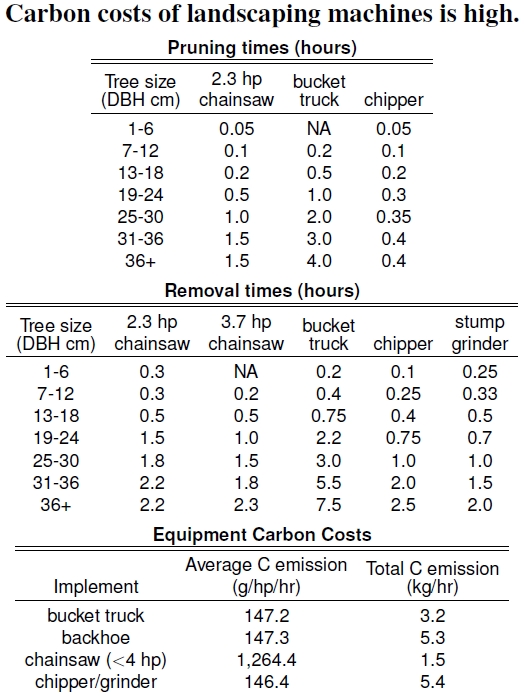3.12 Carbon Costs
Figure 3.12: Maintenance costs associated with trees (after Nowak et al. 2002b). For example, a 31-36 cm DBH tree costs about 17.2 kg of carbon emissions for pruning, calculated by adding use of chainsaws (1.5 hr)(1.5 kgC/hr), bucket truck (4.0 hr)(3.2 kgC/hr), and chipper (0.4 hr)(5.4 kgC/hr). This 17.2 kg. cost nearly equals the annual carbon sequestered by 31–46 cm DBH trees, 19.1 kg, shown in Figure 3.10.
Burning fossil carbon releases carbon sequestered for millions of years. Recapturing this released carbon—sequestering carbon from the biosphere’s carbon cycle — has gained recent interest. If city dwellers hope that city trees sequester city-spewed carbon, then city tree carbon costs also need accounting. City trees need pruning and removal, and these actions require chainsaws and other fossil-fuel-powered tools, causing carbon emissions over the long term. How much can power-tool dependent urban trees help in the short term? Using the tables presented in Figure 3.12, one can consider carbon sequestration that trees provide versus all of these maintenance costs required in urban areas to determine the net carbon sequestration achieved by planting trees of various species. Shown are the carbon costs of city-maintained trees, detailing required times for various powered equipment to prune and remove trees of different sizes.
As an example, let’s consider a tree of size 31 to 36 cm DBH. According to these numbers, pruning costs about 17.2 kg of carbon, and complete removal costs about 43 kg of carbon. Compare these numbers with annual sequestration rates of 19.1 kg of carbon and total carbon storage of 400 kg for 31 to 46 cm DBH trees in Figure 3.10. Keep in mind the shading and cooling benefits of urban trees, but if an urban tree needs significant pruning and, in the end, careful removal, its carbon sequestration role doesn’t look great. Of course, cities don’t prune every tree every year, so these numbers overstate an urban tree’s annual carbon costs.
Carefully taking into account these costs and benefits, the study from which these numbers came calculated tree-species-specific breakeven times — a measure of when carbon used to maintain a tree exceeds the carbon sequestered by the tree.[55] Breakeven times vary between species because their growth habits differ, and the rank ordering of tree species reveals good and bad tree species for pulling carbon out of the air. The winners? Tulip trees (Liriodendron tulipifera) and white oaks (Quercus alba)! I love tulip trees because they grow so fast, providing shade very quickly with low biogenic emissions (see Figure 4.3). At the opposite end, river birch (Betula nigra) and pin cherry (Prunus pennsylvanica) perform poorly.
I reemphasize that bacterial and fungal decomposition releases all of the carbon sequestered by trees back into the atmosphere, even without considering the maintenance carbon costs tabled here. That means carbon sequestration is somewhat mythical. Pruning and tree removal happen because humans want to control the fall of branches and the trunk upon tree death, hoping to avoid greater economic consequences. Only by burying dead trees deep underground, where fossil fuels come from, can we truly sequester a tree’s carbon for a significant time span.
—————————–
[55]Nowak et al. (2002b) discuss carbon costs of power tools and breakeven times for different trees.
